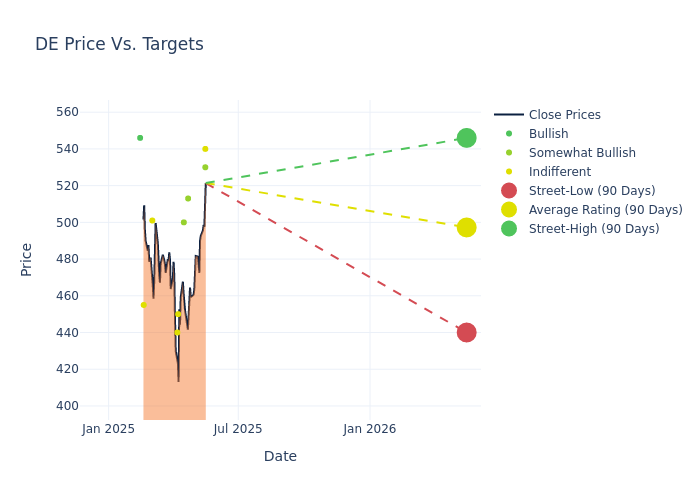What Analysts Are Saying About Deere Stock
Across the recent three months, 8 analysts have shared their insights on Deere (NYSE:DE), expressing a variety of opinions spanning from bullish to bearish.
The following table provides a quick overview of their recent ratings, highlighting the changing sentiments over the past 30 days and comparing them to the preceding months.
| Bullish | Somewhat Bullish | Indifferent | Somewhat Bearish | Bearish | |
|---|---|---|---|---|---|
| Total Ratings | 0 | 3 | 5 | 0 | 0 |
| Last 30D | 0 | 1 | 1 | 0 | 0 |
| 1M Ago | 0 | 2 | 0 | 0 | 0 |
| 2M Ago | 0 | 0 | 2 | 0 | 0 |
| 3M Ago | 0 | 0 | 2 | 0 | 0 |
Insights from analysts' 12-month price targets are revealed, presenting an average target of $491.12, a high estimate of $540.00, and a low estimate of $440.00. This upward trend is apparent, with the current average reflecting a 3.26% increase from the previous average price target of $475.62.

Breaking Down Analyst Ratings: A Detailed Examination
A comprehensive examination of how financial experts perceive Deere is derived from recent analyst actions. The following is a detailed summary of key analysts, their recent evaluations, and adjustments to ratings and price targets.
| Analyst | Analyst Firm | Action Taken | Rating | Current Price Target | Prior Price Target |
|---|---|---|---|---|---|
| Adam Seiden | Barclays | Raises | Overweight | $530.00 | $475.00 |
| Tami Zakaria | JP Morgan | Raises | Neutral | $540.00 | $490.00 |
| Kristen Owen | Oppenheimer | Raises | Outperform | $513.00 | $510.00 |
| Angel Castillo | Morgan Stanley | Raises | Overweight | $500.00 | $450.00 |
| Kyle Menges | Citigroup | Lowers | Neutral | $450.00 | $480.00 |
| Steven Fisher | UBS | Lowers | Neutral | $440.00 | $462.00 |
| Mircea Dobre | Baird | Maintains | Neutral | $501.00 | $501.00 |
| David Raso | Evercore ISI Group | Raises | In-Line | $455.00 | $437.00 |
Key Insights:
- Action Taken: Analysts adapt their recommendations to changing market conditions and company performance. Whether they 'Maintain', 'Raise' or 'Lower' their stance, it reflects their response to recent developments related to Deere. This information provides a snapshot of how analysts perceive the current state of the company.
- Rating: Offering insights into predictions, analysts assign qualitative values, from 'Outperform' to 'Underperform'. These ratings convey expectations for the relative performance of Deere compared to the broader market.
- Price Targets: Analysts predict movements in price targets, offering estimates for Deere's future value. Examining the current and prior targets offers insights into analysts' evolving expectations.
For valuable insights into Deere's market performance, consider these analyst evaluations alongside crucial financial indicators. Stay well-informed and make prudent decisions using our Ratings Table.
Stay up to date on Deere analyst ratings.
About Deere
Deere is the world's leading manufacturer of agricultural equipment and a major producer of construction machinery. The company is divided into four reporting segments: production & precision agriculture (PPA), small agriculture & turf (SAT), construction & forestry (CF), and financial services (FS), its captive finance subsidiary. The core PPA business is the largest contributor to sales and profits by far. Geographically, Deere sales are 60% US/Canada, 17% Europe, 14% Latin America, and 9% rest of world. Deere goes to market through a robust dealer network that includes over 2,000 dealer locations in North America with reach into over 100 countries. John Deere financial provides retail financing for machinery to its customers and wholesale financing for dealers.
Key Indicators: Deere's Financial Health
Market Capitalization: Exceeding industry standards, the company's market capitalization places it above industry average in size relative to peers. This emphasizes its significant scale and robust market position.
Negative Revenue Trend: Examining Deere's financials over 3M reveals challenges. As of 31 January, 2025, the company experienced a decline of approximately -30.25% in revenue growth, reflecting a decrease in top-line earnings. When compared to others in the Industrials sector, the company faces challenges, achieving a growth rate lower than the average among peers.
Net Margin: Deere's net margin surpasses industry standards, highlighting the company's exceptional financial performance. With an impressive 10.52% net margin, the company effectively manages costs and achieves strong profitability.
Return on Equity (ROE): The company's ROE is a standout performer, exceeding industry averages. With an impressive ROE of 3.84%, the company showcases effective utilization of equity capital.
Return on Assets (ROA): The company's ROA is a standout performer, exceeding industry averages. With an impressive ROA of 0.83%, the company showcases effective utilization of assets.
Debt Management: Deere's debt-to-equity ratio surpasses industry norms, standing at 2.88. This suggests the company carries a substantial amount of debt, posing potential financial challenges.
Analyst Ratings: What Are They?
Within the domain of banking and financial systems, analysts specialize in reporting for specific stocks or defined sectors. Their work involves attending company conference calls and meetings, researching company financial statements, and communicating with insiders to publish "analyst ratings" for stocks. Analysts typically assess and rate each stock once per quarter.
Analysts may enhance their evaluations by incorporating forecasts for metrics like growth estimates, earnings, and revenue, delivering additional guidance to investors. It is vital to acknowledge that, although experts in stocks and sectors, analysts are human and express their opinions when providing insights.
Which Stocks Are Analysts Recommending Now?
Benzinga Edge gives you instant access to all major analyst upgrades, downgrades, and price targets. Sort by accuracy, upside potential, and more. Click here to stay ahead of the market.
This article was generated by Benzinga's automated content engine and reviewed by an editor.
 Wall Street Journal
Wall Street Journal